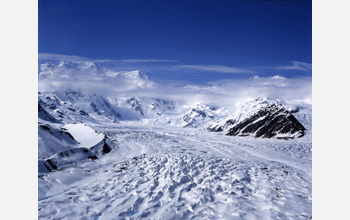Multimedia Gallery
Kennicott Glacier, Alaska
View of Kennicott Glacier, Alaska, looking toward 16,390 foot Mt. Blackburn in its headwaters. Research on this Alaskan glacier by a small team of researchers based out of the University of Colorado, led by Robert and Suzanne Anderson and graduate student Tim Bartholomaus, takes advantage of an annual outburst flood from a side-valley Hidden Creek Lake. The outburst flood serves as a probe of how the hydrologic system of a glacier influences its sliding speed, which in turn governs how glaciers erode the landscape. Detailed measurement of the glacier's speed using five global positioning system monuments, water depths in side-glacier lake basins and water discharge in the outlet river, strongly argue that basal motion (sliding and/or till deformation) occurs whenever water inputs into the glacier exceed the capacity of the glacial plumbing system to transmit the water. The data imply that the excess water backs up into the distributed cavity system at the glacier bed, increasing the pressures that promote sliding. This overcharging of the plumbing system occurs during diurnal melt cycles, seasonal cycles and during the huge annual outburst flood that runs a natural hydrology experiment on the glacier each summer.
This image was taken on a fixed-wing flight over the Kennicott Glacier en route to a deployment for global positioning system monuments on the glacier surface early in the melt season of 2006. [Research supported by National Science Foundation Small Grant for Exploratory Research award from NSF's Earth science division, EAR 05-49566.] (Date of Image: May 2006)
Credit: Robert Anderson, INSTAAR and the Department of Geological Sciences, University of Colorado
Images and other media in the National Science Foundation Multimedia Gallery are available for use in print and electronic material by NSF employees, members of the media, university staff, teachers and the general public. All media in the gallery are intended for personal, educational and nonprofit/non-commercial use only.
Images credited to the National Science Foundation, a federal agency, are in the public domain. The images were created by employees of the United States Government as part of their official duties or prepared by contractors as "works for hire" for NSF. You may freely use NSF-credited images and, at your discretion, credit NSF with a "Courtesy: National Science Foundation" notation.
Additional information about general usage can be found in Conditions.
Also Available:
Download the high-resolution JPG version of the image. (4.9 MB)
Use your mouse to right-click (Mac users may need to Ctrl-click) the link above and choose the option that will save the file or target to your computer.

